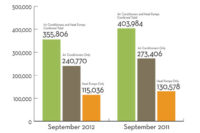The apprentice: Allen Charles Edwards (ACE) — first-year mechanic.
The technician: N. Arthur Thomas Egan (NATE) — 15-year HVACR veteran.
NATE and ACE are preparing to install the backup resistance heating for a heat pump.
NATE: We’re going to be installing the heaters in the air handler. It’s a factory-made unit, so the installation should be a breeze. The load calculation calls for 25,000 British thermal units (Btu). Will the heater be able to deliver? Now remember, we’ll be installing a 10 kilowatt (kW) heater rated at 240 volts (V), but the electric utility will only supply the home with 208 volts.
ACE: If I remember correctly, I should be able to figure this out mathematically. Let’s see — I think it’s called a ratio and proportion calculation. I’ll just compare the 10 kW heater input voltage (240 V) with the delivered voltage (208 V).
I think the answer should be 34,130 Btu.
NATE: I think you missed some details. Let’s walk through the process step by step.
1
We need to use Watt’s Law to determine the amperage draw of the heater at its design voltage. The amperage draw would be:
a. 20.80 amps
b. 24.00 amps
c. 36.11 amps
d. 41.66 amps
2
Then using Ohm’s Law, we can calculate the resistance of the heater. The resistance of the heater is:
a. 10.00 ohms
b. 7.50 ohms
c. 5.76 ohms
d. 2.08 ohms
3
Now that we’ve determined the resistance of the heater, we can calculate the new amperage draw at the supplied voltage again using Ohm’s Law. The amperage draw of the heater being supplied 208 V is:
a. 41.66 amps
b. 36.11 amps
c. 24.00 amps
d. 20.80 amps
4
With the new amperage draw we can calculate the supplied wattage using Watt’s Law along with the supplied voltage. The supplied wattage is:
a. 10 kW
b. 8.6 kW
c. 7.5 kW
d. 6.0 kW
5
And, finally, we can calculate the proper amount of Btu’s being supplied by the heater at the supplied voltage. The approximate amount supplied equals:
a. 25,000 Btu
b. 25,625 Btu
c. 29,550 Btu
d. 34,130 Btu
NATE: Well, Ace, will the heater do the job?
ACE: It sure will.
NATE: Then let’s complete the installation.
Ohm’s Law
E = I x R
I = E/R
R = E/I
E = Voltage I = Amperage R = Resistance
Watt’s Law
(Power Formula)
Watts = Volts x Amps
Conversion
KW to Btu per hour (Btuh)
1,000 Watts = 3,413 Btuh
Author’s Note
Please remember no question appearing in these articles is on a NATE exam. These questions and dialogue are my creation alone. The NATE Technical Committee does not review the article content, and the committee has the final decision for the use of a question on the tests.
Interpretation of codes, regulations, and standards comes from my experience as a technician and a contractor. Different jurisdictions have varying interpretations. The particular area a job is being done in will dictate which viewpoint is to be properly used.
I learn a lot from your commentary and try to incorporate information into the next article, so please continue to comment.
Patrick L. Murphy
Director of Technical Development
NATE
pmurphy@natex.org
Answers: 1) d; 2) c; 3) b; 4) c; 5) b.
Patrick Murphy is Director of Technical Development, North American Technician Excellence. If you have any further questions or comments on this quiz, contact Murphy at pmurphy@natex.org.
Publication date: 09/29/2003




